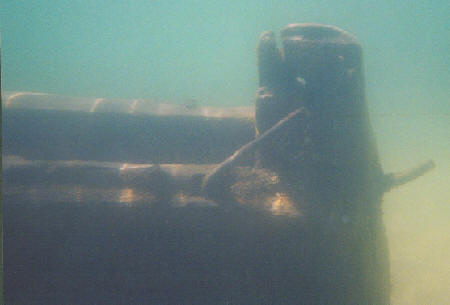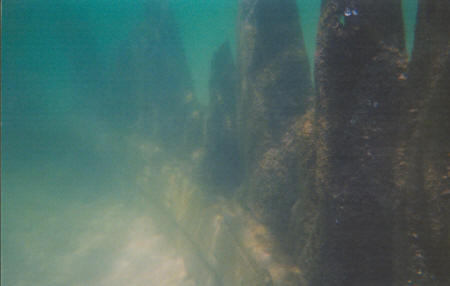N 43° 15.003′
W 086° 21.152′
The Helen was built as a 2-masted scow schooner in 1881, by Wolf & Davidson, of Milwaukee. The vessel was 90′ in length and 23′ wide. This made her quite a stout, beamy vessel. Her flat-bottomed hull and retractable center board made her an ideal sailing vessel for visiting shallow harbors. Her draft was only 7′. At 120 gross tons, 114 net, she was very economical to operate. The Helen was lucky enough to be photographed (above). Her career wasn’t very long and sail driven vessel photographs from that era are rare.
As the first storm clouds rolled into Chicago, the captain of the schooner Topsey turned to Mrs. Von Thadden and urged her not to sail. She’d already sent the children ashore. Why not stay with behind with them? She laughed and explained that she could never do that. It was hard enough keeping Captain John sober when he was where she could keep an eye on him. If she didn’t sail with the Helen, she said, there’d be no freight, money or vessel left once it reached White Lake. And without the Helen, the family would be penniless.
Captain John Von Thadden was well known and respected by most every sailor on the Big Lake. And where Capt. John went, so did Mrs. Von Thadden. She was of medium build, fortyish, with a light complexion. She collected the money, hired the crew, and devoted her spare time to keeping her good natured consort sober.
The Helen had delivered a cargo of lumber to Chicago and was headed back to the sawmills on White Lake for more. Mrs. Von Thadden was said to be carrying as much as $600. It was a run the Helen had made countless times since she was built in built in Milwaukee, five years earlier.
So Mrs. Von Thadden was aboard when the 90-foot long, flat bottomed lumber ship set sail from Chicago on November 17, 1886. The boat was manned by a crew of four men and a boy, according to reports printed in the Muskegon Daily Chronicle shortly after the wreck.
Careful readers of that day’s edition of the Daily Chronicle took note of a one-paragraph item on the paper’s back page headed, “A Blizzard on It’s Way.” It warned of an approaching “second-class storm of considerable magnitude and force.”
The storm blew in from the southwest, beginning with a light drizzle. Plummeting temperatures and strong winds quickly turned the rain into driving snow. Soon, the winds were strong enough to blow stacked lumber in Muskegon Lake and stop streetcars in their tracks.
Veteran Great Lakes sailor David Dall called it the worst storm he’d ever experienced. The well-known Chicago ship-owner walked ashore when the William Jones beached on Little Sable Point, south of Pentwater.
The great storm of 1886 overwhelmed the Helen sometime during the night of November 17-18. She was probably leaking from the heavy pounding she was taking from heavy seas. Despite the furious efforts of seasick crewmen at the hank pumps in the hold, she became waterlogged.
Scow schooners like the Helen had flat bottoms which allowed them to take on cargos in the shallow water ports along West Michigan. It also made them hard to steer, even under the best of conditions.
Captain Von Thadden may have been running for the safety of Muskegon Lake, or may just have been running for shore when the Helen foundered roughly 3 miles north of the channel.
When she struck, 100 yards offshore, Von Thadden and the crew had two choices – take to the rigging and hope the lifesaving crew found then before they froze to death, or swim for shore through freezing water in waves 12 feet high or higher.
The storm sank at least 10 ships and drowned as many as 39 men and women before it finally subsided. In an era when a vessel like the Helen was worth about $4,000, shipping losses from the November 18 storm reached nearly $640,000.
At dawn, November 18, the Helen and her wreckage were strewn across the Muskegon coast. On November 20, a farmer discovered Capt. John’s body on the beach three miles north of Muskegon and notified the community’s Life Saving station.
A strong wind washed Mrs. Von Thadden’s body ashore on November 24, 1886, six days after the Helen had foundered. It was the day before Thanksgiving Day. We can only imagine how lonely the holiday season of 1886 was for the Von Thadden’s orphaned children. According to the November 24 Muskegon Daily Chronicle, “She was wearing a sailor’s coat over her dress. There was $25.45 found in her pocket. This was in gold, silver and paper. Some of it was loose in her pocket, the other in a small bag. No other effects were found.”
MSRA member David Miesch discovered the wreck of the lumber schooner Helen, of Chicago, about 3 miles north of the Muskegon channel during a family outing on Labor Day, 2002.
Dave, his brother Ray and cousin Max Dyga and their families had spent Sunday afternoon at the Shoreline Spectacular festival in Muskegon. After listening to a band and enjoying other activities downtown, the group decided to head out on their pleasure boats to the coastline north of the Muskegon Lake channel for a swim.
Dyga’s boat anchored 60 feet from shore, Ray anchored another 40 feet out. Dave’s daughter Megan and niece Becky decided to swim toward Dyga’s boat. Becky began to struggle but, with Megan’s help, made it safely to shore.
Dave stated “Megan said her feet kept hitting something.” Dave then investigated and found what appeared to be timbers close to the surface. “Everyone was a little exasperated at Becky’s close call, so we left. But it stuck in my mind that something was down there.” said Dave.
A few days later he returned with an inner tube, his daughter’s scuba mask and his dog Molly. “There was a whole ship down there. It was so cool,” said Dave of his discovery. “It was the total outline of a ship from stem to stern. It’s all ribs on the south side, but there is planking on the north side. The back end is squared off. Obviously shipwrecks are not only discovered by scuba divers with thousands of dollars worth of equipment.

The Helen’s stern post
Later surveys but MSRA members in 2002, revealed many artifacts and features. The wreck is shallow, with the maximum depth at the stern at 12′. The stern was fully exposed that year and divers could swim under the fantail where the rudder used to attach. Heading forward, there was a large chain piled in the center of the open hull. The chain extended over the port side of the wreck, extended and disappeared into the sand. About halfway to the bow, the centerboard trunk rose 6′ from the hull bottom and extended like a wall about 10′ forward. In the bow area a capstan arm juts out of the sand, obviously attached to a buried capstan. An intact deadeye assembly still adorns the wreck. Many vintage bottles from the thirties and the fifties tell us the wreck uncovers from time to time and was used by fisherman, who discarded those bottles while fishing. The lack of zebra mussels testifies to the fact that the Helen had only recently uncovered.
In the Spring of 2003, the Helen had again started to disappear under the sand. The stern area that was 12′ deep only 6 months earlier, was now at a depth of 4′. Only the outline of her hull and partly exposed centerboard trunk was exposed. The wreck can be seen from sand dunes on shore.
With changing water levels and shifting sands, the Helen will continue to experience “rediscovery” every few years by new explorers.



